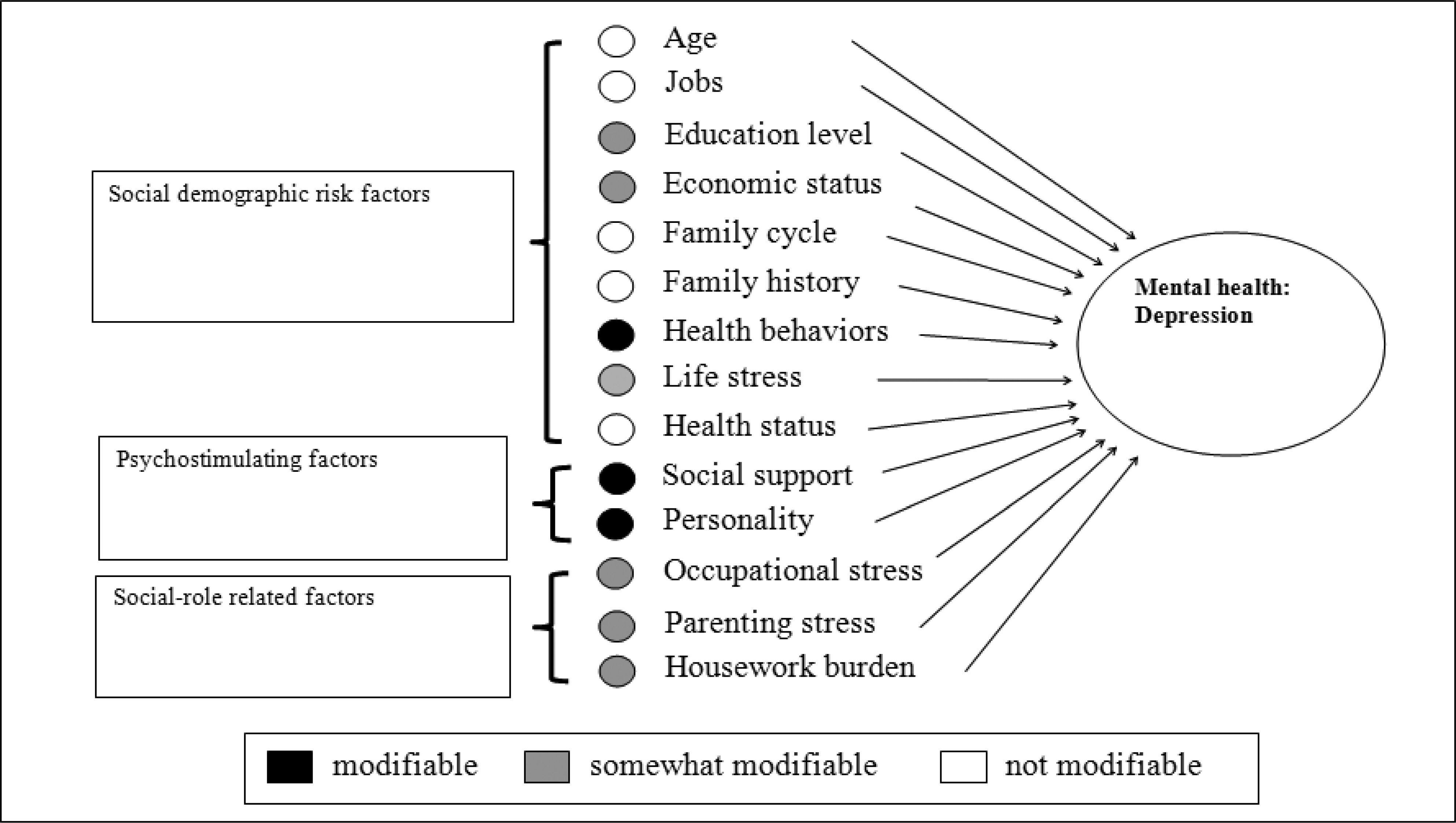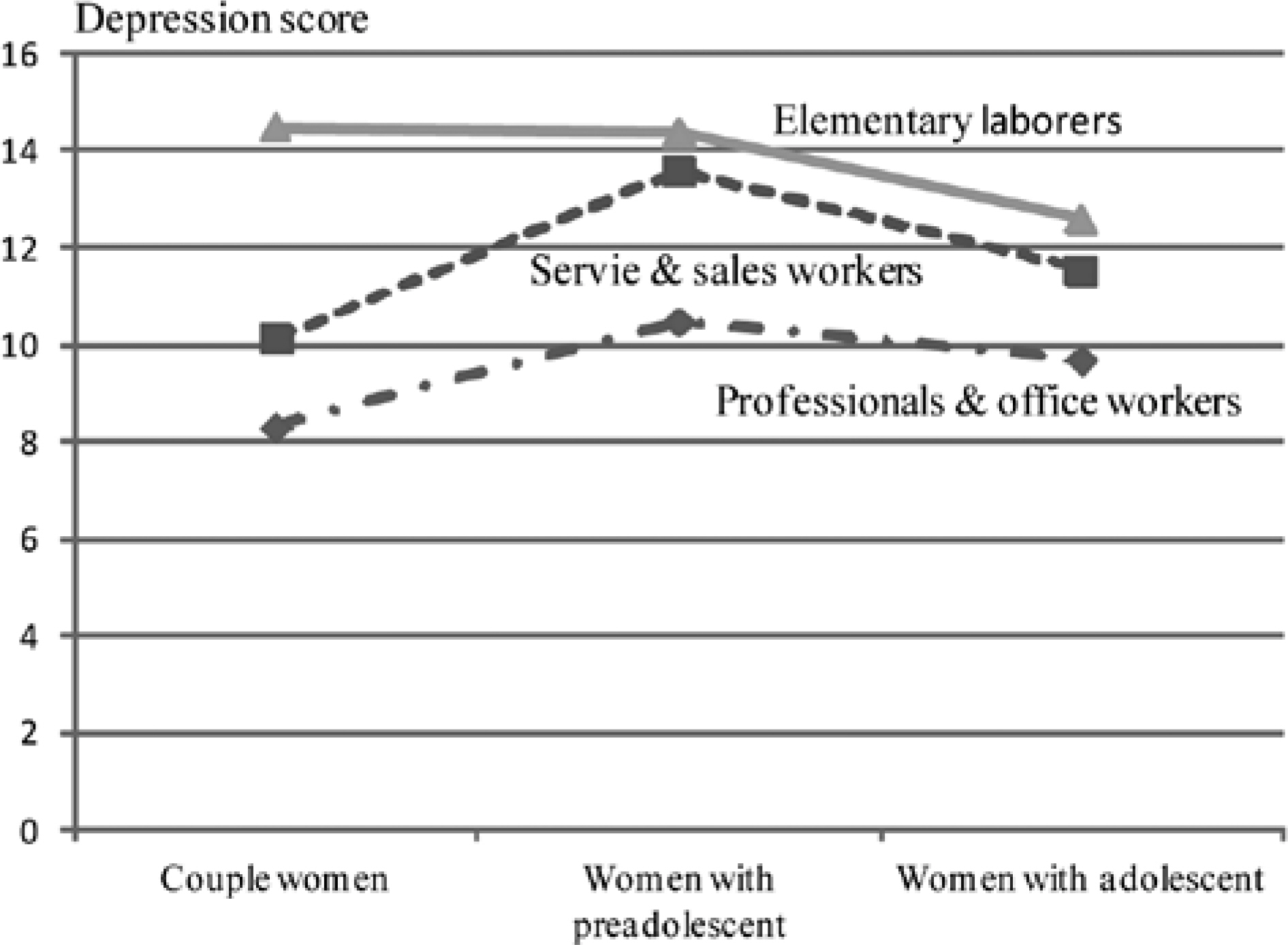J Korean Acad Nurs.
2012 Aug;42(4):496-507. 10.4040/jkan.2012.42.4.496.
Depression of Married and Employed Women Based on Social-Role Theory
- Affiliations
-
- 1Department of Nursing, Inha University, Incheon, Korea.
- 2College of Nursing, Chungnam University, Daejeon, Korea. sukheeahn@cnu.ac.kr
- 3College of Nursing, Eulji University, Daejeon, Korea.
- 4College of Nursing, Research Institute of Nursing Science, Seoul National University, Seoul, Korea.
- 5Department of Nursing, Kwandong University, Gangneung, Korea.
- 6Department of Nursing, Silla University, Busan, Korea.
- 7Department of Nursing, Seoyoung University, Gwangju, Korea.
- KMID: 1387322
- DOI: http://doi.org/10.4040/jkan.2012.42.4.496
Abstract
- PURPOSE
This study was based on social-role theory, and purposes were to investigate (1) how depression and health determinants vary with married and employed women, and (2) what factors contribute to depression according to family cycle.
METHODS
A stratified convenience sample of 765 married and employed women was recruited during May to August 2010. Study variables of depression, socio-demographic threatening factors, psycho-stimulating factors, and social-role related factors were measured via a structured questionnaire.
RESULTS
Prevalence rate for depression was 18.6%, with highest rate (25.4%) from elementary laborers. Greater levels of depression were related to women's occupation, higher life stress, and poorer health; lower social support and vulnerable personality; higher levels of social-role related stress. From multivariate analysis, women with preadolescents were the most vulnerable to depression affected by occupation, life stress, personality, and parenting stress. These factors (except for occupational class) combined with economic status, social support, and housework unfairness were significant for depression in women with adolescents.
CONCLUSION
Depression among married and employed women differs by psycho-stimulating and social role relevant factors in addition to occupational class and family life cycle. Female elementary laborers and women with children need to have the highest prioritization for community mental health programs.
Keyword
MeSH Terms
Figure
Cited by 3 articles
-
Life's Experiences of Middle-aged Divorced Women with Higher Education and Profession
Hyeong-Sook Park, Young-Sil Bae, Sung-Hwa Lee, Su-Jeong Yu, So-Young Jeon
Korean J Women Health Nurs. 2016;22(1):11-20. doi: 10.4069/kjwhn.2016.22.1.11.Mediating Effect of Meaning in Life on the Relationship between Social Connectedness and Depression among Middle-aged Women
Jung A Son, JinJu Kim, Myung Sun Hyun
J Korean Acad Psychiatr Ment Health Nurs. 2019;28(4):373-381. doi: 10.12934/jkpmhn.2019.28.4.373.Factors Affecting Unmet Healthcare Needs of Working Married Immigrant Women in South Korea
Jinseon Yi, Insook Lee
J Korean Acad Community Health Nurs. 2018;29(1):41-53. doi: 10.12799/jkachn.2018.29.1.41.
Reference
-
References
Abidin, R. 1995. Parenting stress index. 3rd ed.Odessa, FL: Psychological Assessment Resources, Inc.Ahn S.H. 2004. Physical health and depression in women by employment status and role satisfaction. Korean Journal of Women Health Nursing. 10:23–31.
ArticleAneshensel C. S.., Frerichs R. R.., Clark V.A. 1981. Family roles and sex differences in depression. Journal of Health and Social Behavior. 22:379–393.
ArticleArber, S. 1991. Class, paid employment and family roles: Making sense of structural disadvantage, gender and health status. Social Science & Medicine. 32:425–436.Barnett R.., Baruch. G. 1987. Social roles, gender, and psychological distress. Barnett R., Biener L., Baruch G., editorsGender and stress. New York: Free Press.Beck A. T.., Steer R. A.., Ball R.., Ranieri W.F. 1996. Comparison of Beck depression inventories-IA and-II in psychiatric outpatients. Journal of Personality Assessment. 67:588–597.
ArticleBipolar disorder, worse than depression. 2011. May 2. Health insurance Review & Assessment Service. Retrieved June 1, 2011, from. http://www.hira.or.kr/cms/rc/rce_news/1205271_10816.html.Brommelhoff J. A.., Conway K.., Merikangas K.., Levy B.R. 2004. Higher rates of depression in women: Role of gender bias within the family. Journal of Women's Health. 13:69–76.
ArticleBrown G. W.., Andrews B.., Harris T.., Adler Z.., Bridge, L. 1986. Social support, self-esteem and depression. Psychological Medicine. 16:813–831.
ArticleChang S. J.., Koh S. B.., Kang M. G.., Cha B. S.., Park J. K.., Hyun S. J., et al2005. Epidemiology of psychosocial distress in Korean employees. Journal of Preventive Medicine and Public Health. 38:25–37.Cho I. S.., Park Y.S. 2004. Transition model of middle-aged women. Journal of Korean Academy of Nursing. 34:515–524.
ArticleCho S. J.., Jang S. N.., Cho S.I. 2008. Multiple roles and health among Korean women. Journal of Preventive Medicine & Public Health. 41:355–363. http://dx.doi.org/10.3961/jpmph.2008.41.5.355.
ArticleChung K. M.., Lee K. S.., Park J.A. 2008. Korean parenting stress index: Expert guide. Seoul: Hakjisa.Davidson K. W.., Trudeau K. J.., Roosmalen E.., Stewart M.., Kirkland, S. 2006. Gender as a health determinant and implications for health education. Health Education & Behavior. 33:731–743. http://dx.doi.org/10.1177/1090198106288043.Dietch K. V.., Bunney, B. 2002. The "silent" disease. Diagnosing and treating depression in women. AWHONN Lifelines. 6:140–145. http://dx.doi.org/10.1111/j.1552-6356.2002.tb00053.x.Duvall E.M. 1988. Family development's first forty years. Family Relations. 37:127–134. http://dx.doi.org/10.2307/584309.
ArticleGlass J.., Fujimoto, T. 1994. Housework, paid work, and depression among husbands and wives. Journal of Health and Social Behavior. 35:179–191.
ArticleKarasek R.., Theorell, T. 1990. Healthy work: Stress, productivity and the reconstruction of working life. New York: Basic Books, Inc.Katz H.M. 2006. Study design and statistical analysis: A practical guide for clinicians. Cambridge: Cambridge Universi ty Press.Kim I. H.., Chun, H. 2009. Employment and married women's health in Korea: Beneficial or harmful? Journal of Preventive Medicine and Public Health. 45:323–330.
ArticleKim M. S.., Lee I. S.., Lee C.S. 2007. The validation study 1 of Korean BDI-2: In female university students sample. Korean Journal of Psychology. 26:997–1014.Korea Centers for Disease Control and Prevention. 2010. National health and nutrition examination survey: The 4th (2008) results report: 2008 National health statistics. Seoul: Ministry of Health, Welfare and Family.Korean Statistical Office. 2010. Korean standard statistical classification: Statistics Korea. Korean Statistical Information Service;Retrieved October 1, 2010, from. http://www.index.go.kr/.Kwon S.S. 2009. The relationship between job stress and turnover intention of independent contractors in Korea. Quarterly Journal of Labor Policy. 9:119–156.Lahelma E.., Arber S.., Kivela K.., Roos, E. 2002. Multiple roles and health among British and Finnish women: Theinfluence of socioeconomic circumstances. Social Science & Medicine. 54:727–740. http://dx.doi.org/10.1016/S0277-9536(01)00105-8.Laursen B.., Coy K. C.., Collins W.A. 1998. Reconsidering changes in parent-child conflict across adolescence: Ameta-analysis. Child Development. 69:817–832. http://dx.doi.org/10.1111/j.1467-8624.1998.tb06245.x.Lee J. H.., Lee E.H. 2000. The moderating effect of coping strategies upon multiple role conflicts and depression within dual employed couples. Korean Journal of Health Psychology. 5:287–303.Luecken L. J.., Suarez E. C.., Kuhn C. M.., Barefoot J. C.., Blumenthal J. A.., Siegler I. C., et al1997. Stress in employed women: Impact of marital status and children at home on neurohormone output and home-strain. Psychosomatic Medicine. 59:352–359.Ministry of Health & Welfare. 2006. The epidemiological survey of psychiatric illnesses in Korea. Seoul: Author.Moorhead S.., Johnson M.., Maas L. M.., Wanson, E. 2008. Nursing outcomes classification (NOC). Fourth edition. St. Louis: Mosby Elsevier.Noble R.E. 2005. Depression in women. Metabolism. 54(5 Suppl 1):49–52. http://dx.doi.org/10.1016/j.metabol.2005.01.014.
ArticlePark Y.S. 2002. A crisis model for the early adolescent. Unpublished doctoral dissertation. Seoul National University;Seoul:Paykel E.S. 1991. Depression in women. British Journal of Psychiatry. 158(Suppl 10):22–29.
ArticleSung H. M.., Kim J. B.., Park Y. N.., Bai D. S.., Lee S. H.., Ahn H.N. 2008. A study on the reliability and the validity of Korean version of the Beck depression inventory-II(BDI-II). Journal of the Korean Society of Biological Therapies in Psychiatry. 14:201–212.
- Full Text Links
- Actions
-
Cited
- CITED
-
- Close
- Share
- Similar articles
-
- A Grounded Theory Approach on the Multiple Role Experience of Married Women Graduate Students
- Correlates of Depression among Married Immigrant Women in Korea
- Physical Health and Depression in Women by Employment Status and Role Satisfaction*
- Factors Influencing Depression in Married Immigrant Women in Korea
- Factors Predicting Depressive Symptoms in Employed Women: Comparison between Single and Married Employed Women in Korea



